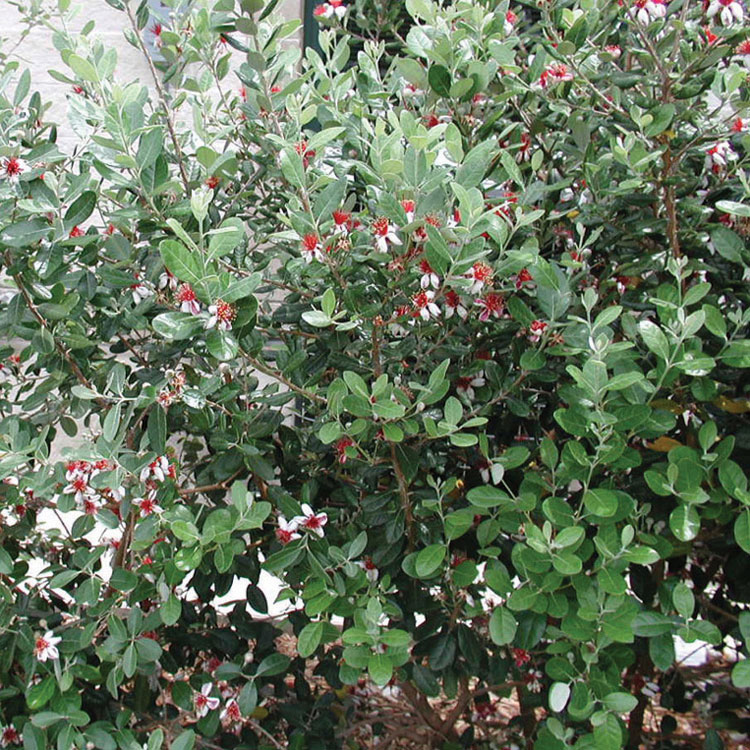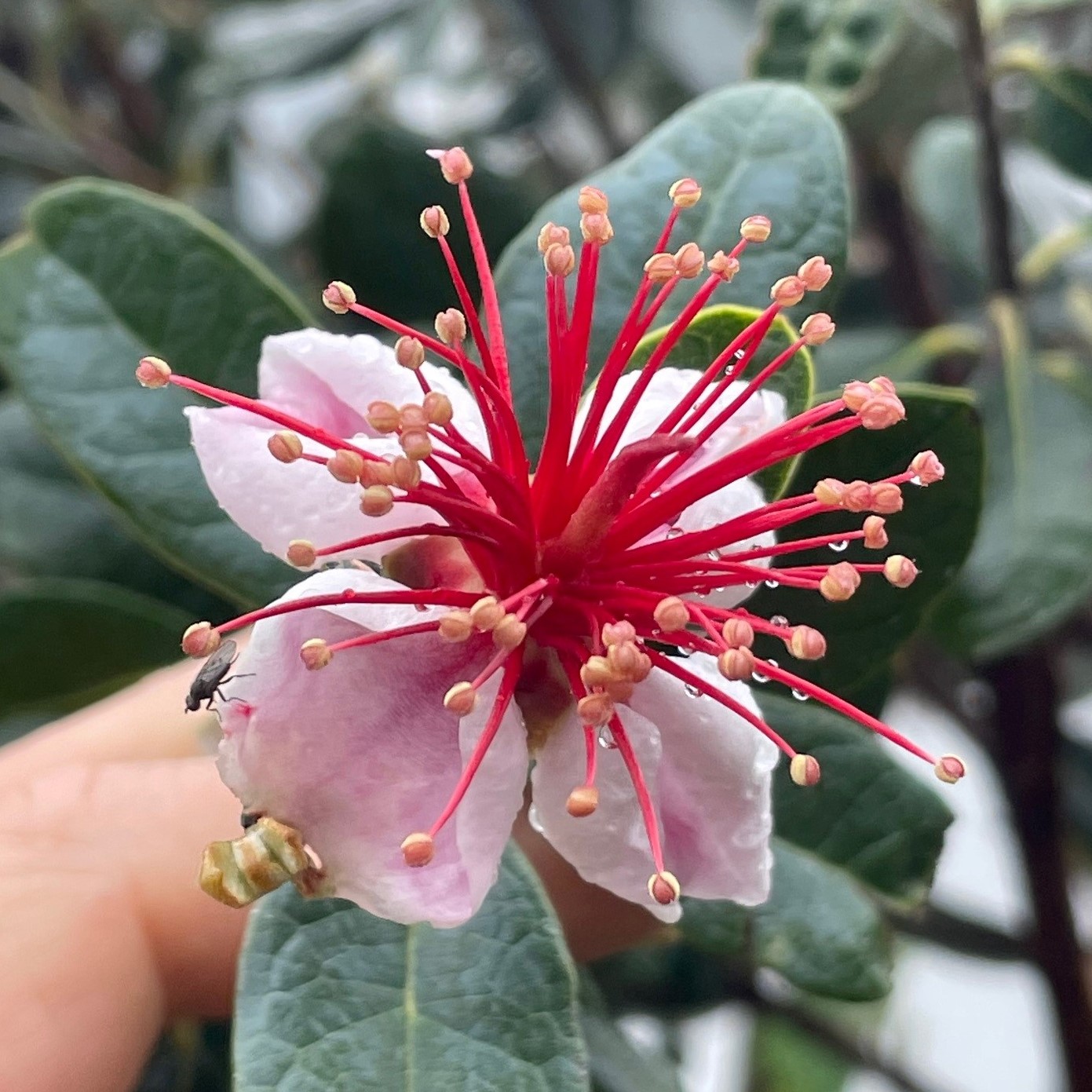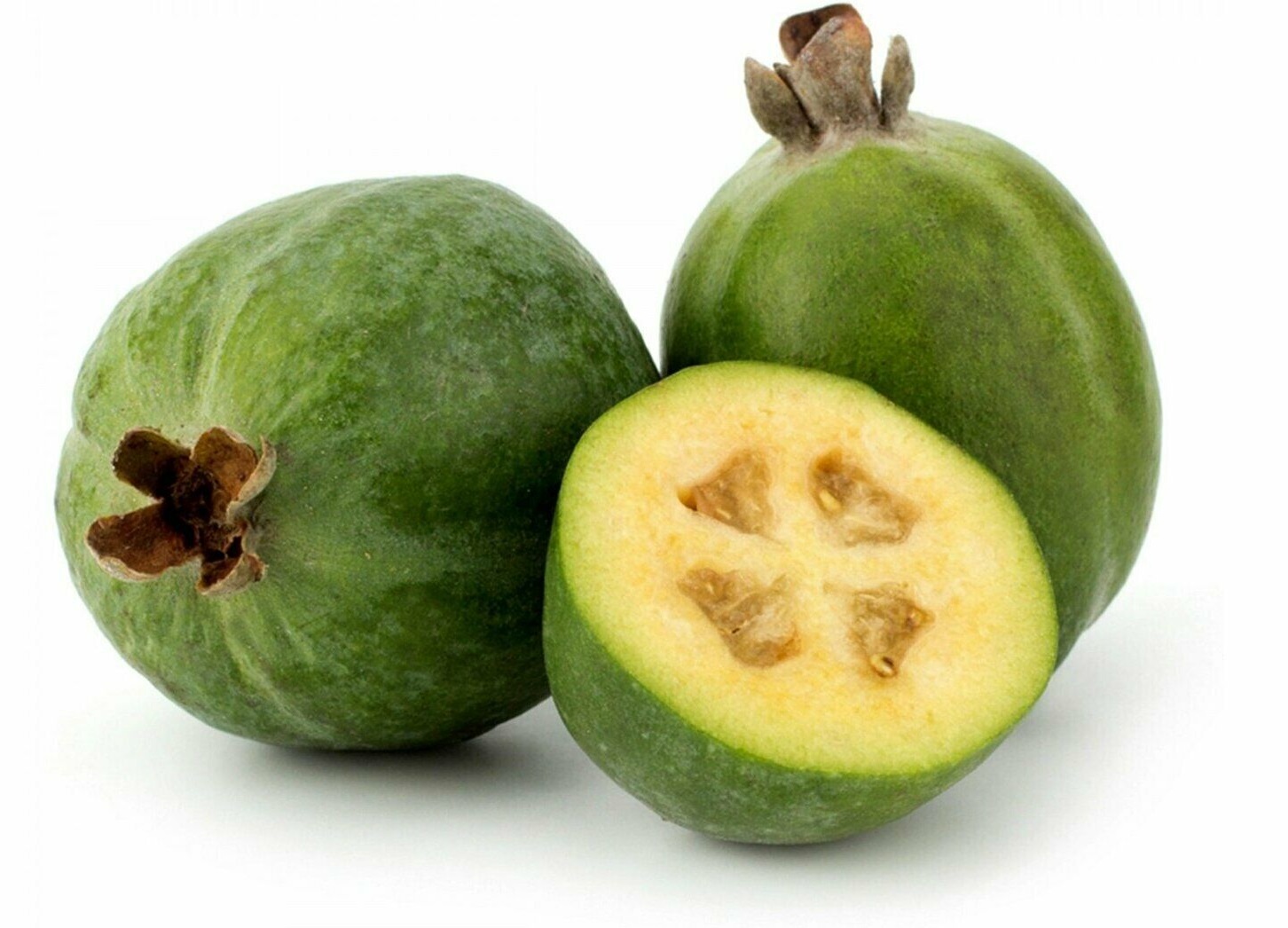How to Grow Pineapple Guava (Feijoa) ColdHardy Tropical Fruit

Pineapple Guava AustinTexas.gov
Feijoa sellowiana (F). pineapple guava. An evergreen shrub with grey-green leaves densely white-felted on the underside. In summer, flowers with four red petals, white on the outside, appear in the leaf axils; occasionally produces edible, red-flushed green fruit

Feijoa sellowiana Pineapple Guava (4.5" Pot) Little Prince To Go
Feijoa sellowiana , or Pineapple Guava, is a gray-green evergreen shrub or tree (depending on pruning) which produces small, tasty fruit in late summer and early fall. The plants can be pruned to form a hedge or a small tree and will withstand several degrees below freezing. It is native to South America.

Pineapple Guava Feijoa Feijoa sellowiana Organic 10 Etsy
The feijoa fruit, which was named after a former director of the National History Museum in Spain who had the last name Feijo, is sweet and fragrant, falling off the pineapple guava tree once it's heavy and ripe.. Is pineapple guava the same as guava? Not exactly. The pineapple guava tree is different than the more commonly known guava tree (Psidium guajava), although the two species are.

Acca sellowiana, Feijoa, Pineapple guava seeds for sale
Pineapple guava ( Feijoa sellowiana) is an attractive, evergreen tree or shrub with many landscape uses. It's ideal for warm, western climates and well suited to home gardens. The plant grows 12 to 15 feet (4-5 m.) tall and wide. The edible flowers bloom in May, followed in late summer or fall by sweet, fragrant, reddish fruit that drops to the.

Feijoa sellowiana Pineapple guava tree, Guava tree, Feijoa
Acca sellowiana, or pineapple guava as it is commonly called, is not a guava at all. It is actually in the Myrtle family, Myrtaceae, and is native to South America. The flower petals are edible, and picking the petals will not inhibit the fruit from forming.

Feijoa (Pineapple Guava) Urban Seedling
Other names: Pineapple guava started with the scientific name Feijoa sellowiana, then was reclassified as Acca sellowiana.A 2019 paper in Systemic Botany titled "A New Subtribal Classification of Tribe Myrteae (Myrtaceae)" helped reinstate the name Feijoa sellowiana, although the two names are often used interchangeably by reliable sources.Also confusing: they have multiple common names.

Pineapple Guava Plant Feijoa Acca sellowiana 4" Pot eBay
Pineapple Guava - Feijoa sellowiana - 3 Gallon Pot; Pineapple Guava is a tropical-looking evergreen shrub or small tree admired and prized for it's uniquely beautiful and sugar sweet flavored edible flowers and tasty tropical-like fruit. The 1 to 1.5-inch flowers have curled petals with white undersides and fuchsia-pink topsides and a bouquet.

How to Grow Pineapple Guava (Feijoa) ColdHardy Tropical Fruit
Feijo, also called pineapple guava, is a small oval fruit with smooth, gray-green skin and creamy white flesh that is juicy and pearlike. The flavor of feijoa is sweet and reminiscent of pineapple, pear, and banana. Feijo fruit resembles unripe medium-sized guava from a distance. The fruit is 2½ inches long and 2 inches in diameter. Related.

How to Grow Pineapple Guava (Feijoa) ColdHardy Tropical Fruit
Soil Type & Mulch. Pineapple guava grows easily in average garden soil. For the best results, plant your feijoa in moderately rich, well-drained soil with a pH between 5.5 and 7.0. The one thing they will not tolerate is constantly soggy soil, so be sure to plant them in a location where drainage is not an issue.

Feijoa Sellowiana Pineapple Guava
Pineapple guava goes by another name in many parts of the world - feijoa.Scientifically known as Acca sellowiana, the plant that bears this fruit is a shrub or small tree native to regions including Argentina, Paraguay, Uruguay, Brazil, and Colombia.It is also grown in large quantities in New Zealand and is widely cultivated over the world for its sweet fruit, as well as for ornamental purposes.

What Is A Feijoa Tree Learn About Care And Uses Of Pineapple Guava
Guava fruit is 1-3" long with a waxy blue-gray-green skin with a green edible inner pulp. Ripe fruits can be harvested by placing a tarp under the tree and shaking. Ripe fruits have a perfumy fragrance and taste like mint-apple or pineapple-mint. Tree-ripened fruit will have better flavor than fruit ripened indoors.

Photo of the Day Feijoa (aka Pineapple Guava) Pineapple guava
To grow these trees from seed, you will need well-draining small pots, light soil, grow lights, and a heating mat. Plant the seeds indoors in the early spring. Bury each seed around 1 to 1 1/2 inches deep. Keep the soil moist and place the pots on a heating mat under grow lights. Keep the heating mat on constantly.

Feijoa Pineapple Guava Hello Hello Plants & Garden Supplies
The plant is also commonly known as feijoa. Pineapple guava can easily be pruned to form a dense hedge or trained into a small tree with a single trunk. Left unpruned, it can reach up to 15 feet tall and 15 feet wide. For added interest, try training it as an espalier. The evergreen, egg-shaped leaves are 2 to 3 inches long and have silvery.

Shop Live Pineapple Guava Fruit Tree For Sale
Feijoa sellowiana 'Tharfiona'. Most Pineapple Guavas are grown from seed, and mature plants can be unpredictable. Bambina™️ is a dwarf variety grown from cuttings, which makes them very uniform, and perfect for smaller spaces. Tasty guava like fruit ripens in the fall.

16 REMARKABLE BENEFITS OF PINEAPPLE GUAVA (FEIJOA)
Versatile, and easy to grow with an upright branching form, edible flowers, and tropical fruit! Fleshy white flower petals have showy red accents, contrasting nicely with the gray-green foliage. Tasty guava-like fruit ripens in late fall. Easily trained as espalier, a hedge, or a small specimen tree for landscape or container. Monrovia Pineapple Guava are grown from seed and are thus not a.

Feijoa Pineapple Guava The Diggers Club
Pineapple guava feijoa are really very easy fruit trees and can grow in a range of soil conditions. For optimum growth, rich fertile soil that's also well-draining will give feijoa the best start and continued healthy growth. Ideal soil pH is 5.5-7 and you can use a soil pH monitor to test the soil. But even in less than ideal soil conditions.